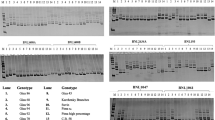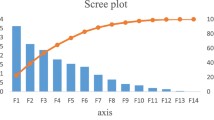Abstract
Upland cotton (Gossypium hirsutumL) is an important crop that is cultivated in warm climates through-out the world. Agronomic performance and fiber quality must continually be improved if cotton is to maintain economic viability. Primitive ancestors of cotton contain diversity for trait improvement; however, many of these accessions have a short-day flowering response (photoperiodic) and are not readily useable in breeding programs. In this study, 114 day-neutral derived primitive germplasm lines were evaluated in field trials for two years. Agronomic and fiber trait data were collected and analyzed. Variance components, genotypic values, and genotypic correlations were calculated. Genotypic effects for all traits studied made significant contributions to the phenotypic variation indicating genetic diversity among these lines. The predicted genotypic values showed a wide range of variation for agronomic and fiber traits. Weak genotypic correlations were found between yield and 2.5% span length and fiber strength, two important fiber traits. Although these day-neutral derived accessions had lower lint percentage, they had improved fiber length, strength, micronaire, and comparable yields with two commercial cultivars. Thus, these day-neutral derived accessions are sources of genetic variation that when used in breeding programs offer the potential to improve important traits and expand genetic diversity.
Similar content being viewed by others
References
Baird, D. & R. Mead, 1991. The empirical efficiency and validity of two neighbor models. Biometrics 47: 1473–1487.
Besag, J. & R. Kempton, 1986. Statistical analysis of field experiments using neighboring plots. Biometrics 42: 231–251.
Gleeson, A.C. & B.R. Cullis, 1987. Residual maximum likelihood (REML) estimation of a neighbor model for field experiments. Biometrics 43: 277–288.
McCarty, J.C. Jr. & J.N. Jenkins, 1992. Characteristics of 79-neutral primitive race accessions. Mississippi Agricultural and Forestry Experiment Station Technical Bulletin 184.
McCarty, J.C. Jr., J.N. Jenkins & B. Tang, 1995. Primitive cotton germplasm: variability of yield and fiber traits. Mississippi Agricultural and Forestry Experiment Station Technical Bulletin 202.
McCarty, J.C., Jr., J.N. Jenkins & J. Zhu, 1998a. Introgression of day-neutral genes in primitive cotton accessions: I. Genetic variances and correlations. Crop Sci 38: 1425–1428.
McCarty, J.C., Jr., J.N. Jenkins & J. Zhu, 1998b. Introgression of day-neutral genes in primitive cotton accessions: II. Predicted Genetic Effects. Crop Sci 38: 1428–1431.
McCarty, J.C., J.N. Jenkins & J. Wu, 2003. Use of primitive accessions of cotton as sources of genes for improving yield components and fiber properties. Mississippi Agric and For Exp Stn Bull 1130.
McCarty, J.C., J.N. Jenkins & J. Wu, 2004a. Primitive accession germplasm by cultivar crosses as sources for cotton improvement I: Phenotypic values and variance components. Crop Sci 44: 1226–1230.
McCarty, J.C., J.N. Jenkins & J. Wu, 2004b. Primitive accession germplasm by cultivar crosses as sources for cotton improvement II: Genetic effects and genotype values. Crop Sci 44: 1231–1235.
McCarty, J.C., J.N. Jenkins & J. Wu, 2005. Potential of primitive accessions for cotton improvement. Mississippi Agric and For Exp Stn Bull 1141.
Meredith, W.R. Jr., 1990. Yield and fiber-quality potential for second generation hybrids. Crop Sci 30: 1045–1048.
Miller, R.G., 1974. The jackknife: A review. Biometrika 61: 1–15.
Percival, A.E., 1987. The national collection of Gossypium germplasm. Southern Cooperative Series Bulletin 321.
Percival, A.E. & R. Kohel, 1990. Distribution, collection, and evaluation of Gossypium. Adv Agron 44: 225–256.
SAS Institute, 2001. SAS software Version 8.0. SAS Institute, Cary, NC.
Tang, B., J.N. Jenkins, C.E. Watson, J.C. McCarty & R.G. Creech, 1996. Evaluation of genetic variances, heritabilities, and correlations for yield and fiber traits among cotton F2 hybrid populations. Euphytica 91: 315–322.
Tang, B., J.N. Jenkins, J.C. McCarty & C.E. Watson, 1993a. F2 hybrids of host plant germplasm and cotton cultivars:I. Heterosis and combining ability for lint yield and yield components. Crop Sci 33: 700–705.
Tang, B., J.N. Jenkins, J.C. McCarty & C.E. Watson, 1993b. F2 hybrids of host plant germplasm and cotton cultivars: II. Heterosis and combining ability for fiber properties. Crop Sci 33: 706–710.
William, E.R., 1986. A neighbor model for field experiments. Biometrika 73: 279–287.
Wu, J., H. Xu & J. Zhu, 1998. An approach to eliminating systematic errors in genetic analysis. In: L.S. Chen, S.G. Ruan & J. Zhu (Eds.), Advanced Topics in Biomathematics: Procceedings of International Conference on Mathematical Biology, pp. 265–270. World Scientific Publishing Co., Singapore.
Wu, T., D.E. Mather & P. Dutilleul, 1998. Application of geostatistical and neighbor analysis to data from plant breeding trials. Crop Sci 1545–1553.
Zhu, J., 1989. Estimation of genetic variance components in the general mixed model. Ph.D. Dissertation, NC State University, Raliegh (Diss. Abstr. DA8924291).
Zhu, J., 1993. Methods of predicting genotype value and heterosis for offspring of hybrids. J Biomathematics 8(1): 32–44.
Author information
Authors and Affiliations
Corresponding author
Additional information
Contribution of the USDA-ARS in cooperation with the Mississippi Agric. and Forestry Exp. Stn. Mention of trademark, proprietary product, or vendor does not constitute a guarantee or warranty of the product by USDA, ARS and does not imply its approval to the exclusion of other products or vendors that may also be suitable.
Rights and permissions
About this article
Cite this article
McCarty, J.C., Wu, J. & Jenkins, J.N. Genetic diversity for agronomic and fiber traits in day-neutral accessions derived from primitive cotton germplasm. Euphytica 148, 283–293 (2006). https://doi.org/10.1007/s10681-005-9027-x
Received:
Accepted:
Published:
Issue Date:
DOI: https://doi.org/10.1007/s10681-005-9027-x




